Spatiotemporal variation in vegetation phenology and its response to climate change in marshes of Sanjiang Plain, China
- PMID: 36699565
- PMCID: PMC9848817
- DOI: 10.1002/ece3.9755
Spatiotemporal variation in vegetation phenology and its response to climate change in marshes of Sanjiang Plain, China
Abstract
Sanjiang Plain is the largest marsh distribution area of China, and marshes in this region significantly affect regional carbon cycle and biodiversity protection. The vegetation phenology of marsh significantly affects the energy exchange and carbon cycle in that region. Under the influence of global climatic change, identifying the changes in phenology and their responses to climatic variation in marshes of Sanjiang Plain is essential for predicting the carbon stocks of marsh ecosystem in that region. Using climate and NDVI data, this paper analyzed the spatiotemporal variations in the start (SOS), end (EOS), and length (LOS) of vegetation growing season and explored the impacts of climatic variation on vegetation phenology in marshes of Sanjiang Plain. Results showed that the SOS advanced by 0.30 days/a, and EOS delayed by 0.23 days/a, causing LOS to increase significantly (p < .05) by 0.53 days/a over marshes of Sanjiang Plain. Spatially, the large SOS advance and EOS delay resulted in an obvious increasing trend for LOS in northern Sanjiang Plain. The rise of spring and winter temperatures advanced the SOS and increased the LOS, and the rise in temperature in autumn delayed the EOS in marshes of Sanjiang Plain. Our findings highlight the necessity of considering seasonal climatic conditions in simulating marsh vegetation phenology and indicate that the different influences of climatic variation on marsh vegetation phenology in different regions should be fully considered to assess the marsh ecosystem response to climatic change in Sanjiang Plain.
Keywords: Sanjiang Plain; climatic change; marsh; phenology; response; vegetation.
© 2023 The Authors. Ecology and Evolution published by John Wiley & Sons Ltd.
Conflict of interest statement
The authors declare no conflict of interest.
Figures
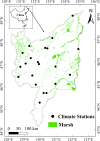


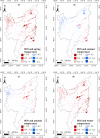
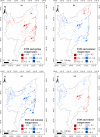
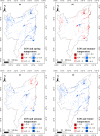
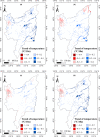
Similar articles
-
Variation in Vegetation Phenology and Its Response to Climate Change in Marshes of Inner Mongolian.Plants (Basel). 2023 May 23;12(11):2072. doi: 10.3390/plants12112072. Plants (Basel). 2023. PMID: 37299051 Free PMC article.
-
Spatiotemporal variation in vegetation spring phenology and its response to climate change in freshwater marshes of Northeast China.Sci Total Environ. 2019 May 20;666:1169-1177. doi: 10.1016/j.scitotenv.2019.02.265. Epub 2019 Feb 21. Sci Total Environ. 2019. PMID: 30970482
-
Spatiotemporal Variation in Aboveground Biomass and Its Response to Climate Change in the Marsh of Sanjiang Plain.Front Plant Sci. 2022 Jun 21;13:920086. doi: 10.3389/fpls.2022.920086. eCollection 2022. Front Plant Sci. 2022. PMID: 35800612 Free PMC article.
-
Critical role of water conditions in the responses of autumn phenology of marsh wetlands to climate change on the Tibetan Plateau.Glob Chang Biol. 2024 Jan;30(1):e17097. doi: 10.1111/gcb.17097. Glob Chang Biol. 2024. PMID: 38273510
-
Impacts of climate change on vegetation phenology and net primary productivity in arid Central Asia.Sci Total Environ. 2021 Nov 20;796:149055. doi: 10.1016/j.scitotenv.2021.149055. Epub 2021 Jul 15. Sci Total Environ. 2021. PMID: 34328878
Cited by
-
Spatial and temporal variation of net primary productivity of herbaceous marshes and its climatic drivers in China.Front Plant Sci. 2024 May 14;15:1380081. doi: 10.3389/fpls.2024.1380081. eCollection 2024. Front Plant Sci. 2024. PMID: 38807779 Free PMC article.
References
-
- Badeck, F. W. , Bondeau, A. , Böttcher, K. , Doktor, D. , Lucht, W. , Schaber, J. , & Sitch, S. (2004). Responses of spring phenology to climate change. The New Phytologist, 162, 295–309.
-
- Bhandari, S. , Phinn, S. , & Gill, T. (2011). Assessing viewing and illumination geometry effects on the MODIS vegetation index (MOD13Q1) time series: Implications for monitoring phenology and disturbances in forest communities in Queensland, Australia. International Journal of Remote Sensing, 32, 7513–7538.
-
- Cao, R. , Chen, Y. , Shen, M. , Chen, J. , Zhou, J. , Wang, C. , & Yang, W. (2018). A simple method to improve the quality of NDVI time‐series data by integrating spatiotemporal information with the Savitzky‐Golay filter. Remote Sensing of Environment, 217, 244–257.
-
- Chatterjee, K. , Bandyopadhyay, A. , Ghosh, A. , & Kar, S. (2015). Assessment of environmental factors causing wetland degradation, using Fuzzy Analytic Network Process: A case study on Keoladeo National Park, India. Ecological Modelling, 316, 1–13.
-
- Duan, S. , He, H. S. , & Spetich, M. (2018). Effects of growing‐season drought on phenology and productivity in the west region of central hardwood forests, USA. Forests, 9, 377.
LinkOut - more resources
Full Text Sources

